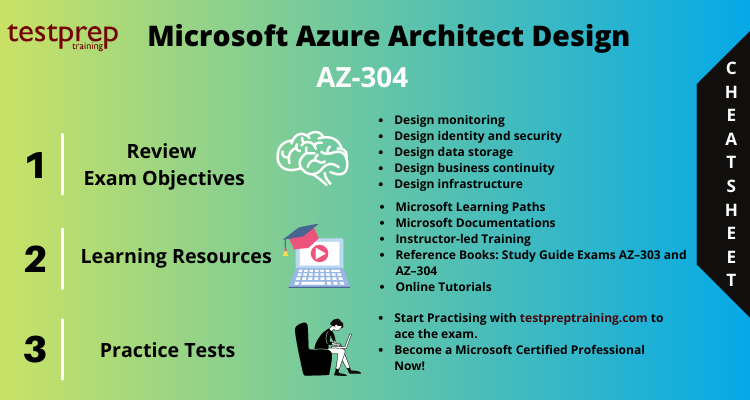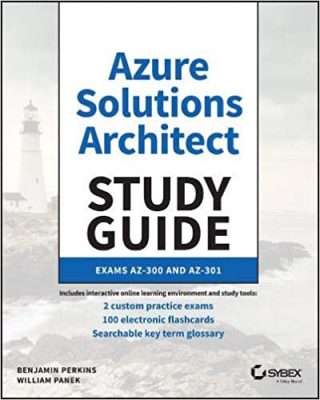Looking for a quick revision for the Microsoft AZ-304 exam? Then you are just at the the right place! This Microsoft Azure Architect Design Cheat Sheet is your ideal instrument to have an overview of the exam before venturing. It will keep you loaded with the right resources and bridge the gap for your dream job. Furthermore, we will be adding a few quick links to ease your preparation process. We suggest you to a quick glance at this cheat sheet before you appear for the exam.
Microsoft AZ-304 : Overview
The Microsoft AZ-304 Microsoft Azure Architect Design exam certifies you to become a Microsoft Azure Architect. Collaborating with cloud administrators, cloud DBAs, and clients, an Azure Solution Architect plays a pivotal role in implementing solutions. Responsibilities for this role encompass advising stakeholders and transforming business requirements into secure, scalable, and dependable cloud solutions. Candidates undertaking this exam are expected to demonstrate subject matter expertise in designing and deploying solutions on Microsoft Azure, covering aspects such as compute, network, storage, and security.
Recommended Knowledge
An individual preparing for this exam should possess extensive experience and expertise in IT operations, covering areas such as networking, virtualization, identity, security, business continuity, disaster recovery, data platform, budgeting, and governance. In this role, one must adeptly navigate decisions in each domain to impact an overarching solution. Furthermore, candidates should demonstrate expert-level proficiency in Azure administration, along with practical experience in Azure development and familiarity with DevOps processes.
Cheat Sheet | Microsoft AZ-304 Azure Architect Design Exam
The Microsoft AZ-304 certification exam Cheat Sheet is crafted to assist you in preparing for the exams. It will guide you through various learning resources, giving you a competitive edge. Without any more delay, let’s embark on your revision journey.

Deeply Analyse the Microsoft AZ-304 Exam Topics
First and foremost thing, when you begin revising for the exam is to deeply analyse the exam objectives. These objectives form the blueprint of the exam. Moreover, the course outline provides detailed description of all the exam concepts.
Microsoft AZ-304 Exam has updates in the course outline as on January 27, 2021.
The updated Microsoft AZ-304 exam topics include:
Design Monitoring (10-15%)
Design for cost optimization
- recommend a solution for cost management and cost reporting (Microsoft Documentation: Choose between Azure Cost Management and Cloudyn)
- recommend solutions to minimize costs (Microsoft Documentation: Optimize costs from recommendations)
Design a solution for logging and monitoring
- determine levels and storage locations for logs (Microsoft Documentation: Configure metrics alerts)
- plan for integration with monitoring tools including Azure Monitor and Azure Sentinel (Microsoft Documentation: Introducing Microsoft Azure Sentinel, intelligent security analytics for your entire enterprise)
- recommend appropriate monitoring tool(s) for a solution
- choose a mechanism for event routing and escalation
- recommend a logging solution for compliance requirements (Microsoft Documentation: Audit activity reports in the Azure Active Directory portal)
Design Identity and Security (25-30%)
Design authentication
- recommend a solution for single-sign on (Microsoft Documentation: What is single sign-on)
- recommend a solution for authentication (Microsoft Documentation: Choose the right authentication method for your Azure Active Directory hybrid identity solution)
- recommend a solution for Conditional Access, including multi-factor authentication (Microsoft Documentation: Common Conditional Access policies)
- recommend a solution for network access authentication (Microsoft Documentation: Azure network security overview)
- recommend a solution for a hybrid identity including Azure AD Connect and Azure AD (Microsoft Documentation: Choose the right authentication method for your Azure Active Directory hybrid identity solution)
- recommend a solution for user self-service (Microsoft Documentation: self-service sign-up for Azure Active Directory)
- recommend and implement a solution for B2B integration
Design authorization
- choose an authorization approach (Microsoft Documentation: Authorization behavior)
- recommend a hierarchical structure that includes management groups, subscriptions, and resource groups (Microsoft Documentation: What are Azure management groups?)
- recommend an access management solution including RBAC policies, access reviews, role assignments, Privileged Identity Management (PIM), Azure AD (Microsoft Documentation: Grant user access to Azure resources using the Azure portal)
- Identity Protection, Just In Time (JIT) access (Microsoft Documentation: Identity Protection policies, Secure your management ports with just-in-time access)
Design governance
- recommend a strategy for tagging (Microsoft Documentation: Resource naming and tagging decision guide)
- recommend a solution for using Azure Policy (Microsoft Documentation: Enabling and managing a Key Vault policy through the Azure portal)
- recommend a solution for using Azure Blueprint
Design security for applications
- recommend a solution that includes KeyVault (Microsoft Documentation: About keys, secrets, and certificates)
- recommend a solution that includes Azure AD Managed Identities (Microsoft Documentation: Use a Windows VM system-assigned managed identity to access Resource Manager)
- recommend a solution for integrating applications into Azure AD (Microsoft Documentation: Integrating Azure Active Directory with applications getting started guide)
Design Data Storage (15-20%)
Design a solution for databases
- select an appropriate data platform based on requirements
- recommend database service tier sizing (Microsoft Documentation: Service tiers in the DTU-based purchase model)
- recommend a solution for database scalability (Microsoft Documentation: Dynamically scale database resources with minimal downtime)
- recommend a solution for encrypting data at rest, data in transmission, and data in use Design data integration
Design data integration
- recommend a data flow to meet business requirements
- recommend a solution for data integration, including Azure Data Factory, Azure Data Bricks, Azure Data Lake, Azure Synapse Analytics (Microsoft Documentation: Copy and transform data in Azure Synapse Analytics)
Select an appropriate storage account
- choose between storage tiers (Microsoft Documentation: Azure Blob storage: hot, cool, and archive access tiers)
- recommend a storage access solution (Microsoft Documentation: Microsoft client tools for working with Azure Storage)
- recommend storage management tools
Design Business Continuity (10-15%)
Design a solution for backup and recovery
- recommend a recovery solution for Azure hybrid and on-premises workloads that meets recovery objectives (RTO, RLO, RPO) (Microsoft Documentation: Reduce disaster recovery time with Azure Site Recovery)
- design and Azure Site Recovery solution (Microsoft Documentation: Replication policy)
- recommend a solution for recovery in different regions (Microsoft Documentation: Plan capacity for Hyper-V VM disaster recovery)
- recommend a solution for Azure Backup management (Microsoft Documentation: About on-premises disaster recovery failover/failback)
- design a solution for data archiving and retention
Design for high availability
- recommend a solution for application and workload redundancy, including compute, database, and storage (Microsoft Documentation: Make all things redundant, Azure Storage redundancy)
- recommend a solution for autoscaling (Microsoft Documentation: Autoscaling)
- identify resources that require high availability
- identify storage types for high availability (Microsoft Documentation: Introduction to the core Azure Storage services)
Design Infrastructure (25-30%)
Design a compute solution
- recommend a solution for compute provisioning (Microsoft Documentation: Choose an Azure compute service for your application)
- determine appropriate compute technologies, including virtual machines, App Services, Service Fabric, Azure Functions, Windows Virtual Desktop, and containers
- recommend a solution for containers
- recommend a solution for automating compute management
Design a network solution
- recommend a network architecture (hub and spoke, Virtual WAN)
- recommend a solution for network addressing and name resolution (Microsoft Documentation: Public IP addresses)
- recommend a solution for network provisioning
- recommend a solution for network security (Microsoft Documentation: What is Azure Private Endpoint)
- recommend a solution for network connectivity to the Internet, on-premises networks, and other Azure virtual networks (Microsoft Documentation: Connectivity services)
- recommend a solution for automating network management
- recommend a solution for load balancing and traffic routing (Microsoft Documentation: Traffic Manager routing methods, Load balance Windows virtual machines in Azure to create a highly available application with Azure PowerShell)
Design an application architecture
- recommend a microservices architecture including Event Grid, Event Hubs, Service Bus, Storage Queues, Logic Apps, Azure Functions, and webhooks (Microsoft Documentation: Building serverless microservices in Azure – sample architecture, Building microservices on Azure)
- recommend an orchestration solution for the deployment of applications including ARM templates, Logic Apps, or Azure Functions (Microsoft Documentation: Azure Automation runbook types)
- recommend a solution for API integration
Design migrations
- assess and interpret on-premises servers, data, and applications for migration (Microsoft Documentation: Assess VMware VMs with Server Assessment, Migrate SQL Server to Azure SQL Database offline using DMS)
- recommend a solution for migrating applications and VMs
- recommend a solution for migration of databases (Microsoft Documentation: Migration of virtual machines)
- determine migration scope, including redundant, related, trivial, and outdated data
- recommend a solution for migrating data (Storage Migration Service, Azure Data Box, Azure File Sync-based migration to a hybrid file server)
Quick Links to your Study Guide
Your resources define the level of your revisions. Here area few quick links that will definitely benefit your revisions and help you ace the exam:
Microsoft learning paths
The Microsoft Azure AZ-304 exam learning paths are the official resources mainly the online classes which are made available by Microsoft for the candidates of Exam AZ-304. These are made available absolutely free of cost and can help in preparing by developing crystal clear concepts for the exam topics. You can access them on the official site or through the links mentioned below –
- Firstly, Architect network infrastructure in Azure
- Secondly, Architect storage infrastructure in Azure
- Moreover, Architect compute infrastructure in Azure
- Also, Architect infrastructure operations in Azure
- Likewise, Architect a data platform in Azure
Instructor led training
The instructor-led training can be the right choice for you if you are an inquisitive person and encounter so many doubts. In the course, AZ-304T00-A: Microsoft Azure Architect Design, Solutions Architects learn how to transform business requirements into secure, scalable, and dependable solutions. The lessons cover design considerations pertaining to logging, cost analysis, authentication and authorization, governance, security, storage, high availability, and migration.
AZ-304 Exam Reference Books

Books are indeed the best-valued resource for preparation. You can refer to multiple books of your choice and can also pick the books from libraries or book stores. The AZ-304 book you can refer to:
Microsoft Azure Architect Technologies and Design Complete Study Guide Exams AZ–303 and AZ–304 Paperback
Online Tutorials
The best way to enhance your knowledge is by referring to Online Tutorials. These AZ-304 Exam tutorials provide in depth understanding about the exam and its concepts. Additionally, it also covers exam details and policies. Therefore learning with Online Tutorials will result in strengthening your preparation.
Evaluate yourself with Practice Test
The practice is what decides your future. Practicing will help you determine where do you lack in performing best and will also help you in getting more confident on the day of the exam by eradicating your silly mistakes. Therefore try attempting multiple AZ-304 exam practice tests before the final race. They will let you identify the loopholes in your revisions and will help you in reaching the next level. Such practice tests boost your confidence and improve your skills. Start Practising Now!



